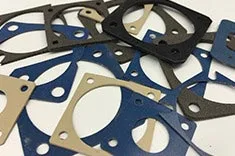EMI Shielding Products
- Custom Gasket Fabrication
- Connector Gaskets
- Bonded O Ring
- Custom Gaskets
- Conduct-O-Knit Knitted Wire Mesh
- Conduct-O-Seal Combo Gasket
- Conduct-O-Elastomer
- Conduct-O-Seal Oriented Wire in Silicone Gasket Material
- Conduct-O-Mesh Tape
- Conduct-O-Foam
- Conduct-O-Bond
- Optical Filters For Electronic Displays
- Shielded Vent Panels
- 300 Series
Preventing Interference with RFI Shields and RFI Filters
Have you ever heard an annoying buzzing noise coming from a radio just before a cell phone rings? The noise directly results from an electronic device interfering with another device nearby. Because of the crowded landscape of modern technology, this problem is of common occurrence daily.

All electronic devices, regardless of size, radiate varying levels of electromagnetic radiation (noise). As a result, a device's operation is in jeopardy of being degraded when it either picks up or transmits unintentional EMI. At a minimum, you'll hear noises from your radio, but medical and other important equipment can malfunction in worst-case scenarios.
The amount of electronics surrounding us in our vehicles, homes, and places of work is overwhelming, which means the causes of RFI continue to grow. Electrical engineers that create electrical circuitry must consider RFI as a critical factor throughout the entire development process.
What can you do to reduce RF interference?
RFI shielding is the standard when it comes to suppressing the emission of RF shielding. Good electrical engineers incorporate shielding into their design as soon as possible. RF shielding is designed to protect vital circuit boards, and it also prevents emission. Different types of guards are used to meet specific applications. Material, thickness, and shape all play critical factors in the performance of RFI shields.
Filters are also used to eliminate emissions that radiate from electronic circuits. Most commonly, engineers use three-pole filters designed to target ranges between 30 MHz and 150 kHz. Filters prevent RFI from interfering with other surrounding devices.
For more information on RFI shielding, give East Coast Shielding a call.
Related Reading about EMI Shielding
- Weatherizing EMI Shielding and RFI ShieldingMake sure to choose a mesh knit layer based on your required electrical performance. Doing this ensures EMI shielding and RFI shielding is working at peak performance.
- Choosing Between Molding and Splicing
- How Does EMI Shielding Work?



